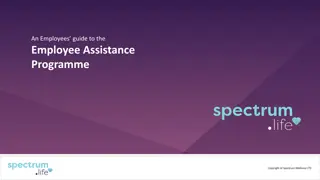Challenges and Rewards of Working with Public Safety - Insights from an EAP Specialist
Gain insights into the unique culture and stressors faced by first responders, and discover effective therapeutic approaches to support them. Learn about the similarities and differences between clinicians and first responders, along with the initial considerations when counseling these individuals.
Download Presentation

Please find below an Image/Link to download the presentation.
The content on the website is provided AS IS for your information and personal use only. It may not be sold, licensed, or shared on other websites without obtaining consent from the author.If you encounter any issues during the download, it is possible that the publisher has removed the file from their server.
You are allowed to download the files provided on this website for personal or commercial use, subject to the condition that they are used lawfully. All files are the property of their respective owners.
The content on the website is provided AS IS for your information and personal use only. It may not be sold, licensed, or shared on other websites without obtaining consent from the author.
E N D
Presentation Transcript
HELPING THE RESCUERS: HELPING THE RESCUERS: CHALLENGES AND REWARDS OF CHALLENGES AND REWARDS OF WORKING WITH PUBLIC SAFETY WORKING WITH PUBLIC SAFETY Brittany Perrotta, LMHC CASAC-T New York City Fire Department, EAP Specialist 1
AGENDA AGENDA Understanding the First Responder culture Work environment and personal/interpersonal stressors of First Responders Differences between working with First Responders vs. civilians Effective strategies and key therapeutic approaches to use with First Responders 2
WORKING WITH PUBLIC SAFETY WORKING WITH PUBLIC SAFETY EMPLOYEES EMPLOYEES Any clinician working with Firefighters, Paramedics, Law Enforcement Officers, Sheriff's Deputies or Dispatchers is entering a closed culture with high levels of distrust for outsiders. First responders see more misery and despair in their first years of their jobs than most of us do in a lifetime. 3
INITIAL CONSIDERATIONS INITIAL CONSIDERATIONS By the time a First Responder seeks counseling, he/she is likely to have been exposed to significant stress, both on and off the job and have been suffering a long time; he/she and their family may feel that they are near the breaking point. Trauma is a whole person injury that may require a collaborative and interdisciplinary team - a 360 view. 4
SIMILARITIES BETWEEN CLINICIANS SIMILARITIES BETWEEN CLINICIANS AND FIRST RESPONDERS AND FIRST RESPONDERS Make a positive difference in peoples lives Problem solvers Relieve suffering Ethical principles Hold a public trust Work in managed bureaucratic structure Subject to organizational stress Exposed to people in pain Risk for burnout and compassion fatigue Objects of stereotypes and derisive humor Emotional dissonance 5
DIFFERENCES DIFFERENCES CLINICIANS Non directive and contemplative Don t impose values on clients Work behind closed doors Value individuality, spontaneity, emotional expression Self actualization and client s feelings PUBLIC SAFETY Action oriented people, value excitement Give and take orders Decisive, work in front of others Value conformity, tradition, team work, structure Use humor to manage stress 6
FIRE SERVICE FIRE SERVICE Culture and Stressors of Firefighters 7
COMMON TRAITS OF COMMON TRAITS OF FIREFIGHTERS FIREFIGHTERS Ability to listen to others Adaptability Perform complex tasks under life- threatening conditions Dedication Expectation for attention to detail Maintain effective working relationships with superiors and subordinates High need for stimulation- easily bored 8
VALUES OF FIREFIGHTERS VALUES OF FIREFIGHTERS The Team Work Ethic Timeliness Strength 1. Strength of Character 2. Mental Strength 3. Physical Strength Sense of Humor 9
NEW GENERATION OF FIREFIGHTERS NEW GENERATION OF FIREFIGHTERS More technologically advanced Less likely to have firefighting as a family tradition Able to speak about their feelings Limited interpersonal communication skills More heterogeneous Promote individuality 10
NEW LANGUAGE NEW LANGUAGE Box Alarm, Job, Worker Line-up Station drill Rookie, Probie On the job A-Shift, B-team, battalions, tour Titles Terminology Organizations Departments EMS, HAZMAT, Prevention, life-safety 11
ISSUES THAT FIREFIGHTERS ISSUES THAT FIREFIGHTERS FACE FACE Stressful work environment Personal/interpersonal stressors Substance abuse issues Physical challenges of the job 12
WORK ENVIRONMENT STRESSORS WORK ENVIRONMENT STRESSORS Sound of alert tone Interrupted sleep cycles Carrying heavy loads Exposure to extreme temperatures Long work hours Shift work Sporadic high intensity situations Distancing from strong emotional involvement Exposure to extreme suffering Victim dynamics 13
PERSONAL/ INTERPERSONAL PERSONAL/ INTERPERSONAL STRESSORS STRESSORS Personality conflicts with coworkers Perceived lack of respect from managers / public /county government Boredom Susceptible to job burnout Concerns over promotion / transfers / retirement Feelings of inadequacy Fear of failure Financial problems Parenting difficulties 14
LAW ENFORCEMENT LAW ENFORCEMENT Culture and Stressors of Law Enforcement 15
COMMON TRAITS OF LAW COMMON TRAITS OF LAW ENFORCEMENT ENFORCEMENT Time driven-crisis response mode Perfectionists intolerant of making mistakes Vigilance checks your office for microphones Command presence stiff and formal Gallows humor they may test you Police culture is about control of self and others Suspiciousness Self- protection 16
VALUES OF LAW ENFORCEMENT VALUES OF LAW ENFORCEMENT Teamwork Integrity Dedication Accountability Initiative Respect 17
LAW ENFORCEMENT STRESSORS LAW ENFORCEMENT STRESSORS Slanted media attention Psychologically hazardous assignments Internet child pornography Undercover work Death notification Corrections Dispatch Gang units Traffic enforcement, serving felony warrants 18
TRAUMATIC INCIDENTS TRAUMATIC INCIDENTS Line of Duty Death Serious Line of Duty injury Suicide of Colleague Death of a child Mass Casualty incidents Terrorism Victim known to the rescuers Excessive News Media interest Prolonged incident - especially with loss 19
SIGNIFICANT OTHERS OF FIRST SIGNIFICANT OTHERS OF FIRST RESPONDERS & THEIR PERSPECTIVE RESPONDERS & THEIR PERSPECTIVE The schedule Nights away from home Holidays Raising kids Emergencies at home when he/she is on duty The second family - competition for priority Ways that the job affects/carries over to the home life Effects of sleep deprivation 20
THERAPEUTIC ALLIANCE THERAPEUTIC ALLIANCE 21
THERAPEUTIC ALLIANCE THERAPEUTIC ALLIANCE Therapists should be transparent, competent, and familiar with first responder culture Authenticity is key!! Stress confidentiality Be empathetic LISTEN = SILENT 22
WORKING WITH FIRST RESPONDERS WORKING WITH FIRST RESPONDERS Do not push for feelings, have the person describe what THEY believe they are feeling Do not visibly overreact to what you hear Respond calmly that must have been difficult for you Validate their feelings When reasonable give advice and confront 23
Focus on coping skills and stress management If this were to pop up, here are somethings to take care of yourself - develop a coping plan Do you have a method that you use? - what has worked for them in the past Give them hope Give them something tangible to work with Have the treatment goals be collaborative Talk about resilience 24
THERAPEUTIC APPROACHES THERAPEUTIC APPROACHES 25
ACCEPTANCE AND COMMITMENT ACCEPTANCE AND COMMITMENT THERAPY THERAPY Client is able to determine their values and establish committed actions that will bring them closer to their established values. Understanding of how past quick fixes have led clients to negative feelings of pain and suffering. Client gains awareness and notices the emotion that they are feeling in the present moment. Frees the client of labeling . 26
OUTSIDE WORLD QUICK FIXES COMMITTED ACTIONS V A L U E S ME NOTICING PAIN VALUE THOUGHTS: FEELINGS: PHYSICAL: INSIDE WORLD 28
COGNITIVE BEHAVIORAL COGNITIVE BEHAVIORAL THERAPY THERAPY Cognitive distortions Vulnerability as a sign of weakness I don t need help I don t want to burden anyone Challenge polarized thinking Magnifying/ Minimizing Accepting lack of control Shoulda Woulda Coulda thinking Survivor Guilt 29
DIALECTICAL BEHAVIORAL THERAPY DIALECTICAL BEHAVIORAL THERAPY Mindfulness: the practice of being fully aware and present in this one moment Distress Tolerance: how to tolerate pain in difficult situations, not change it Interpersonal Effectiveness: communicating in a way that promotes assertiveness, strengthens relationships and maintains boundaries Emotion Regulation: the practice of managing and changing intense emotions 30
CLINICAN SELF CLINICAN SELF- - CARE CARE 31
VICARIOUS TRAUMA VICARIOUS TRAUMA 32
WHAT CAN WE DO FOR WHAT CAN WE DO FOR OURSELVES? OURSELVES? Practice our own self-care Mindfulness Being aware of counter-transference Make an appropriate referral Supervision 33
Q & A 34
CONTACT INFORMATION CONTACT INFORMATION Brittany Perrotta, LMHC CASAC-T Office: (212)- 925- 6671 Brittany.perrotta4@gmail.com 35























